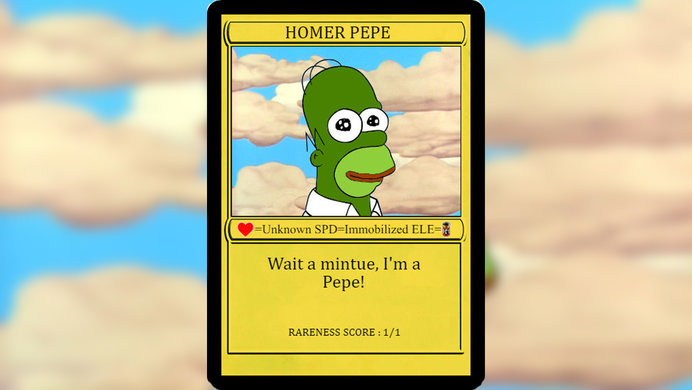Undoubtedly, 2021 was the year that popularized Non-Fungible Tokens (NFTs). Surely, if you have basic knowledge of cryptocurrencies, read news from the world of entertainment, art, or sports, you’ve heard about NFT collections. With them, new ways to prove ownership of digital or physical assets were unlocked.
But do you know their history? That’s quite interesting, and inside the crypto-world, it could even be loosely repeated by another profitable asset in the future. Stay with us to find out how they went from being a technology for art geeks to the hype of 2021.
What are NFTs?
In a previous article, we already explained what NFTs are and how they revolutionize the way to prove ownership over any kind of digital content. Just to remember: NFTs are tokens that can’t be duplicated, copied, or counterfeited, and that record information on the blockchainBlockchain is a type of database storing an immutable set of data, verifiable to anyone with access to it —through... about the assets they represent without being able to be modified. This is specially useful in the artworld.

NFTs provide a certificate of authenticity and ownership over the contents and can be presented by unit or by NFT collections. The latter are series of NFTs with similar characteristics, but which present unique qualities separately. For example, the famous CryptoKitties: all of them are cats, but each one is different from the other.
BitcoinBitcoin is the first decentralized digital currency. It was created in 2009, by an anonymous founder or group of founders... More and the first NFT collections
Colored Coins
The Ethereum blockchain was the first one to popularize NFTs on a worldwide scale. But the truth is this technology dates back to the first years of Bitcoin (BTCAn abbreviation for Bitcoin.). In 2012, the concept of Colored Coins was taking shape from the eToro CEO’s blog and the BitcoinTalk forum.

At the end of that year, a paper was published, describing how to represent and demonstrate ownership of real-world assets on the Bitcoin blockchain using its script. Colored coins were born like this. These are nothing more than Bitcoin transactions, but with a kind of “footprint” (additional data in the protocol) that determines its use as a Colored Coin and establishes a new type of value within the same blockchain.
With them, the doors were opened to a technology that would evolve to the present day to be used in traditional sports, eSports, entertainment, art, legal uses, business, and so on.
And the first NFT?
In the Namecoin blockA collection of cryptocurrency transactions. Every few minutes (or seconds, depending on the blockchain) one miner or validator verifies the... More 174923 came the first minted NFT: “Quantum”, presented by the digital artist Kevin McCoy and developer Anil Dash at a Seven-on-Seven conference. McCoy and his wife Jennifer recorded the 5-second video and on May 2, 2014, it was minted on the Namecoin blockchain (a Bitcoin fork), ushering in a new era of digital art.

The artwork itself is a GIF depicting changing shapes and colors. By then, the concept of Non-Fungible Token (NFT) didn’t exist (and Ethereum either). So, McCoy called the fusion between blockchain and art “monegraphs”, for monetized graphics.
The importance of the first NFT is such that in June 2021 it was sold for $1,472,000 as part of Sotheby’s Natively Digital: A Curated NFT Sale. Also sold there was CryptoPunk #7523, part of another of the most important NFT collections that we’ll name later.
Counterparty and the Rare Pepes
Two years after the first NFT was created, Counterparty entered the scene. This is a P2P, distributedA distributed system is made of components that are running on different networked computers, which communicate and coordinate their actions... More, and open-source platform built on the Bitcoin blockchain. As a second layer of Bitcoin, Counterparty allowed developers to create all kinds of tradable cryptoassets and trade them within the platform in a decentralized marketplace.
With Counterparty began the integration of cryptoassets into video game economies (one of the most prominent being Spells of Genesis and the BitCrystals). This would set the ground for the current Play-To-Earn model.
For their side, the users decided to start a “memeconomy” on this platform. Memes of all kinds gained a lot of popularity thanks to social networks like Facebook, Twitter, and Tumblr. Therefore, a good way to trade them would be to turn them into NFTs, or, by then, unique digital assets. One of the rarest NFT collections of all was born this way: the Rare Pepes. This NFT collection gathers Pepe the Frog memes on Counterparty from 2016.

In early 2017, Rare Pepes started to be traded on Ethereum as well and a live auction was held during the Rare Digital Art Festival. It was in that year that CryptoArt was officially inaugurated with the birth of the Rare Pepe Wallet website. In February 2021, the most expensive Rare Pepe to date (“Homer Pepe”) was sold for $320,000.
First NFT collections on Ethereum
Ethereum is the blockchain on which NFT collections have been minted the most. Among all of them, we can say that the most remarkable ones are CryptoPunks and CryptoKitties, for being the first of their kind – and still some of the most popular and expensive.
CryptoPunks
In June 2017, CryptoPunks arrived. These are 24×24 pixel art images algorithmically generated by Larva Labs on the Ethereum blockchain. Each image is unique and only 10,000 of them exist. Although they don’t fit the ERC721 standard, specially designed for NFTs, or ERC20, which allows smart contracts to interact with each other, the images and their code are stored on the blockchain and can be traded in a decentralized manner at any time.

The most curious part of this? Initially, Larva Labs gave away all CryptoPunks in existence. Anyone with an Ethereum walletA crypto wallet is a user-friendly software or hardware used to manage private keys. There are software wallets for desktop... More could claim any of them at no cost. And they were all claimed quickly. It was a truly unique opportunity for insiders, as at the time few knew about the collection, and no one could have imagined where they would go.
To date, the most expensive CryptoPunk was sold in March this year for $7.58 million, while the cheapest at the time of writing costs around $237,458.26 on Ethereum.
CryptoKitties
CryptoKitties were the NFTs that exploded the market in 2017 and 2018. They were the first famous example of the ERC721 standard, created by Axiom Zen. It’s a game where users can adopt, breed, and trade virtual cats with unique characteristics.
At the peak of its popularity, the Ethereum network was congested by the large number of transactions made with digital kitties. Later, the studio responsible for creating this game became Dapper Labs, also behind nbatopshot.com, where users can collect and trade official NBA and WNBA NFTs.
In the beginning, the average price for CryptoKitties was around $23 each -depending on the piece. They quickly gained a lot of value, though. The most expensive CryptoKitty ever sold is “Dragon”, bought for 600 ETH in 2018 (around $170,000 back then and $2.4 million now).
As we said previously, 2021 was the year that popularized NFTs. Whether in sports, art, video games, or many other applications, they’re here to stay. For many, it’s only a matter of time before in the Metaverse the way to transfer property is through NFTs.
Wanna trade ETH, BTC, and other tokens? You can do it safely on Alfacash! And not forget we’re talking about this and a lot of other things on our social media.
Twitter * Telegram * Instagram * Youtube *Facebook * Vkontakte








